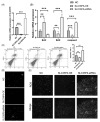Genome-wide association study and subsequent functional analysis reveal regulatory mechanism underlying piglet diarrhea
- PMID: 39482997
- PMCID: PMC11917426
- DOI: 10.5713/ab.24.0547
Genome-wide association study and subsequent functional analysis reveal regulatory mechanism underlying piglet diarrhea
Abstract
Objective: Piglet diarrhea poses a serious threat to piglet health and the livestock economy, and is one of the most pressing problems in animal husbandry. This study aims to investigate the genetic factors involved in piglet diarrhea and to identify key genes that regulate this condition.
Methods: We screened 600 diarrheal piglets based on unique diarrhea scores for resequencing and conducted a genome-wide association study (GWAS). Through this process, we identified 308 single nucleotide polymorphisms (SNPs) and annotated 151 candidate genes. Extensive functional validation and systematic analysis were performed on key candidate genes KSR1, SKAP1, SLC35F6, and OR12.
Results: The study found that the four key genes were involved in the regulation of piglet diarrhea through various mechanisms. OR12 affects the levels of ZO-1 and claudin-1. Changes in the expression levels of KSR1 could alter the expression of IL1-β, IL6, and TNF-α, as well as cell migration and proliferation. SKAP1 could affect the expression of CD3 and CD4, and influence the migration and proliferation ability of cells. SLC35F6 is involved in cell apoptosis through the Bcl2/BAX/caspase3 pathway and can also affect mitochondrial membrane potential.
Conclusion: The results of this study provide strong support for breeding programs aimed at disease resistance and offer potential solutions to the problem of piglet diarrhea.
Keywords: Diarrhea; Genome-Wide Association Study (GWAS); Immunity; Inflammatory; Pig.
Conflict of interest statement
No potential conflict of interest relevant to this article was reported.
Figures








References
Grants and funding
LinkOut - more resources
Full Text Sources
Research Materials

